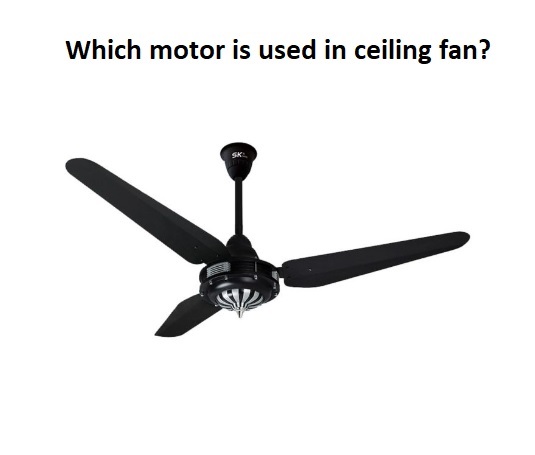Answer:
The motor commonly used in ceiling fans is an induction motor.

Reasoning:
Ceiling fans typically use single-phase induction motors. These motors are chosen for ceiling fans due to their efficiency, simplicity, and cost-effectiveness.
Induction motors work based on electromagnetic induction, a fundamental principle in physics. When an alternating current (AC) flows through the motor’s coils, it creates a rotating magnetic field. This field interacts with the motor’s rotor, inducing currents in it, which in turn generates a torque that causes the rotor to rotate.
There are a few reasons why induction motors are well-suited for ceiling fans:
- Efficiency: Induction motors are relatively efficient, converting a high percentage of electrical input into mechanical output. This efficiency helps keep energy consumption and operating costs low over time.
- Reliability: Induction motors have fewer moving parts compared to other types of motors, resulting in reduced maintenance requirements and increased reliability. This is crucial for ceiling fans, which typically run for extended periods.
- Cost-effectiveness: Induction motors are simpler in design and construction, leading to lower manufacturing costs. This cost-effectiveness makes ceiling fans affordable for a wide range of consumers.
- Speed Control: Induction motors can be easily controlled using simple devices like capacitors or electronic speed controllers. This allows users to adjust the fan’s speed according to their comfort preferences.
- Quiet Operation: Induction motors tend to operate quietly, which is important for ceiling fans used in bedrooms, living rooms, and other spaces where noise levels should be minimized.
- Longevity: Properly maintained induction motors can have a long lifespan, contributing to the overall durability of the ceiling fan.
In summary, the choice of using induction motors in ceiling fans is a balance between efficiency, reliability, cost, and ease of control. These motors provide a practical and effective solution for creating the airflow and cooling effect that ceiling fans are designed to deliver.
FAQs
What type of motor is typically used in ceiling fans?
Ceiling fans predominantly use single-phase induction motors.
Why are induction motors commonly used in ceiling fans?
Induction motors are chosen for their efficiency, reliability, cost-effectiveness, and quiet operation, making them suitable for prolonged use in residential settings.
How does an induction motor work in a ceiling fan?
An induction motor generates a rotating magnetic field when AC current flows through its coils. This field interacts with the rotor, inducing currents that produce the mechanical rotation of the fan blades.
Can you control the speed of a ceiling fan with an induction motor?
Yes, the speed of a ceiling fan with an induction motor can be controlled using methods such as capacitors or electronic speed controllers.
Are there other types of motors used in ceiling fans?
While induction motors are most common, some high-end ceiling fans might use brushless DC (BLDC) motors for enhanced energy efficiency and advanced control features.
Do induction motors require a lot of maintenance in ceiling fans?
No, induction motors have fewer moving parts, leading to lower maintenance requirements compared to other motor types.
Are ceiling fans with induction motors energy-efficient?
Yes, induction motors are relatively efficient, converting a significant portion of electrical input into mechanical output, which helps reduce energy consumption.
Can ceiling fans with induction motors operate silently?
Yes, induction motors are known for their quiet operation, making them suitable for use in bedrooms and other quiet spaces.
Do induction motors have a long lifespan in ceiling fans?
Properly maintained induction motors can have a long lifespan, contributing to the durability of the ceiling fan.
Are there any innovations in motor technology for ceiling fans?
Some manufacturers are exploring brushless DC (BLDC) motors for ceiling fans, which offer even greater energy efficiency and advanced control capabilities compared to traditional induction motors.
 Electrical Engineering World Wiring a Brighter Tomorrow!
Electrical Engineering World Wiring a Brighter Tomorrow!